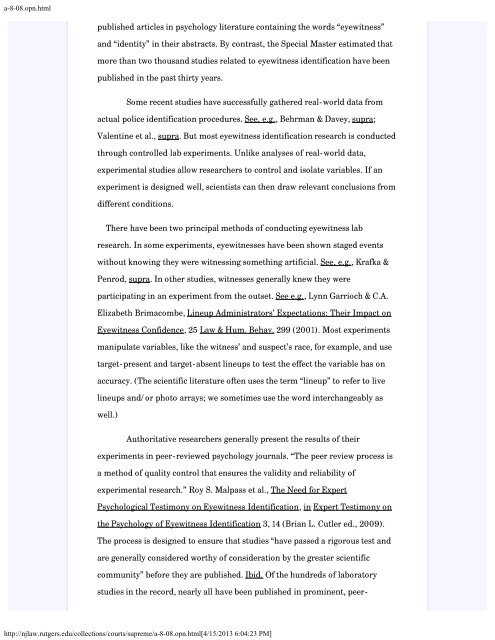State v. Henderson and the New Model Jury Charges - New Jersey ...
State v. Henderson and the New Model Jury Charges - New Jersey ...
State v. Henderson and the New Model Jury Charges - New Jersey ...
Create successful ePaper yourself
Turn your PDF publications into a flip-book with our unique Google optimized e-Paper software.
a-8-08.opn.html<br />
published articles in psychology literature containing <strong>the</strong> words “eyewitness”<br />
<strong>and</strong> “identity” in <strong>the</strong>ir abstracts. By contrast, <strong>the</strong> Special Master estimated that<br />
more than two thous<strong>and</strong> studies related to eyewitness identification have been<br />
published in <strong>the</strong> past thirty years.<br />
Some recent studies have successfully ga<strong>the</strong>red real-world data from<br />
actual police identification procedures. See, e.g., Behrman & Davey, supra;<br />
Valentine et al., supra. But most eyewitness identification research is conducted<br />
through controlled lab experiments. Unlike analyses of real-world data,<br />
experimental studies allow researchers to control <strong>and</strong> isolate variables. If an<br />
experiment is designed well, scientists can <strong>the</strong>n draw relevant conclusions from<br />
different conditions.<br />
There have been two principal methods of conducting eyewitness lab<br />
research. In some experiments, eyewitnesses have been shown staged events<br />
without knowing <strong>the</strong>y were witnessing something artificial. See, e.g., Krafka &<br />
Penrod, supra. In o<strong>the</strong>r studies, witnesses generally knew <strong>the</strong>y were<br />
participating in an experiment from <strong>the</strong> outset. See e.g., Lynn Garrioch & C.A.<br />
Elizabeth Brimacombe, Lineup Administrators’ Expectations: Their Impact on<br />
Eyewitness Confidence, 25 Law & Hum. Behav. 299 (2001). Most experiments<br />
manipulate variables, like <strong>the</strong> witness’ <strong>and</strong> suspect’s race, for example, <strong>and</strong> use<br />
target-present <strong>and</strong> target-absent lineups to test <strong>the</strong> effect <strong>the</strong> variable has on<br />
accuracy. (The scientific literature often uses <strong>the</strong> term “lineup” to refer to live<br />
lineups <strong>and</strong>/or photo arrays; we sometimes use <strong>the</strong> word interchangeably as<br />
well.)<br />
Authoritative researchers generally present <strong>the</strong> results of <strong>the</strong>ir<br />
experiments in peer-reviewed psychology journals. “The peer review process is<br />
a method of quality control that ensures <strong>the</strong> validity <strong>and</strong> reliability of<br />
experimental research.” Roy S. Malpass et al., The Need for Expert<br />
Psychological Testimony on Eyewitness Identification, in Expert Testimony on<br />
<strong>the</strong> Psychology of Eyewitness Identification 3, 14 (Brian L. Cutler ed., 2009).<br />
The process is designed to ensure that studies “have passed a rigorous test <strong>and</strong><br />
are generally considered worthy of consideration by <strong>the</strong> greater scientific<br />
community” before <strong>the</strong>y are published. Ibid. Of <strong>the</strong> hundreds of laboratory<br />
studies in <strong>the</strong> record, nearly all have been published in prominent, peer-<br />
http://njlaw.rutgers.edu/collections/courts/supreme/a-8-08.opn.html[4/15/2013 6:04:23 PM]
















